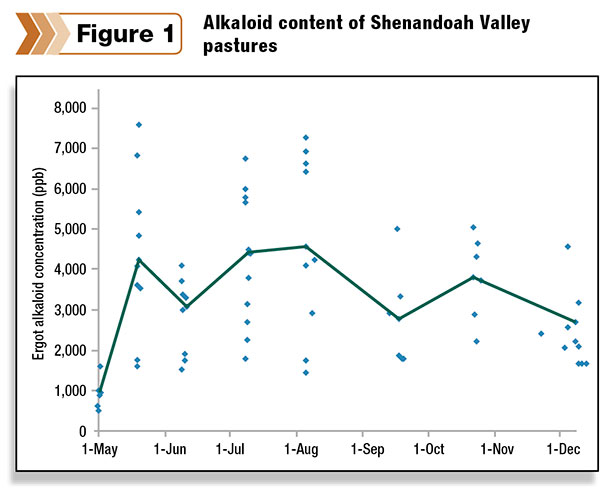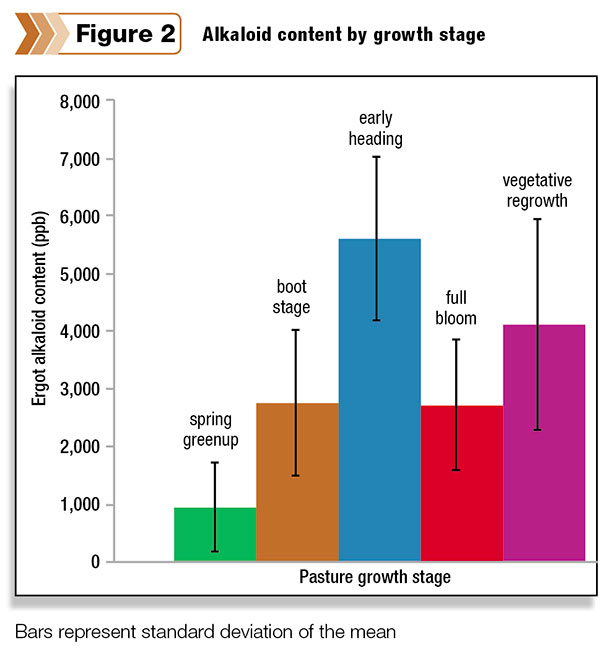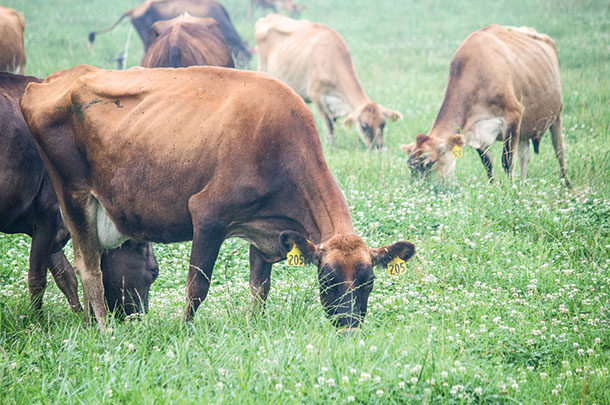While livestock producers in our area are aware of fescue toxicity, most treat it with indifference.
I understand where they are coming from; visible or measurable losses from fescue occur sporadically, and most of the time livestock seem to tough it out pretty well.
Several years ago, I began to question whether fescue toxicity should even be a concern in our area, especially after a search for existing research yielded data that was vague and 30 years old.
While understanding producers’ risks from this issue depends on many factors, it begins by identifying the prevalence of fescue infected with a toxin-producing fungus or endophyte.
In 2013, the Augusta County Extension Office tested 25 prominent farms in Virginia’s Shenandoah Valley for the percentage of fescue infected with the endophyte. Results revealed:
- 65 percent of pastures sampled were 100 percent infected.
- 30 percent of pastures sampled were 80 to 90 percent infected.
- Lowest infection level (one pasture) was 50 percent.
While this information showed that pastures in our area have a lot of potential for toxin production, the logical questions asked by many producers were: “How toxic are they?” and “When are they most toxic?”
So in 2014, we partnered with some of the producers involved in the endophyte survey to track the alkaloid production and forage quality of nine pastures from May to December. Alkaloids are the class of compounds produced by the endophyte that causes fescue toxicosis.
While pastures in the study were fescue-based, each contained other grasses and legumes. We therefore sampled only the fescue in an attempt to better interpret findings. Pastures were sampled every two to three weeks during rapid growth in spring, and monthly after that. It’s important to note that we sampled pastures in a way that mimicked animals’ selection of plant parts.
For example, cattle in this study tended to consume the entire plant – seedhead and all – up to the time of flowering, after which time they ignored stems and seedheads in favor of leafy undergrowth.
The results of our testing were pretty clear: Fescue in the Shenandoah Valley has the potential to be very toxic regardless of the date or stage of growth.
Figure 1 shows a line tracking the average alkaloid content of pastures in the study across the course of the season.
 There is debate about the threshold level of alkaloids that causes animal problems, although most experts would agree it is less than 1,000 parts per billion (ppb).
There is debate about the threshold level of alkaloids that causes animal problems, although most experts would agree it is less than 1,000 parts per billion (ppb).
In this study, all pastures rose quickly above this threshold in the spring and stayed high throughout the season (Figure 2).

The many data points shown in Figure 1 represent the 68 individual samples. A look at these points shows the enormous variability that existed among fields – in many cases, even on the same farm.
There did not appear to be any difference between fescue grazed continuously versus that grazed rotationally. In general, fescue toxicity appeared to peak at the early heading stage of plant growth
(Figure 2).
Based on conventional thinking, we expected alkaloid concentrations to be lower under management systems that result in more vegetative regrowth of forage. Most university recommendations state that clipping or close grazing of pastures will reduce pasture toxicity, as the endophyte and associated alkaloids are concentrated in stems and seedheads.
In this study, however, we found the alkaloid concentration of pastures kept in a vegetative state were just as high as those where plants were flowering or setting seed (Figure 2). This is likely due to activity of the endophyte in rapidly growing plant tissue.
We also tracked the nutritional value of fescue through the year. It’s worth noting that the protein and energy content of pastures dropped quickly around the time of seedhead emergence and stayed relatively low for several months.
Based on the data gathered from our study, a 550-pound steer gaining 2 pounds per day on pasture in May would find itself on grass supporting only 0.5 to 1 pound of average daily gain during June and July (using NRC values). Add fescue toxicosis, and things get even worse. Unfortunately, I have worked with many livestock producers who have complained about the very lack of animal performance in summer demonstrated in this example.
Another area of concern that stood out in our study was the trace mineral content of the pastures. We found that the zinc and copper content of pastures often tested below animal requirements through spring and summer.
The fields in our study all had a history of poultry litter use (though not recently), so our findings were a bit of a surprise. It is a good reminder to keep a complete mineral mix that includes trace elements in front of cattle at all times.
So how do our findings relate to the many instances where we are dealing with mixed-species pastures rather than monoculture stands of fescue? Thankfully, most producers have diverse pastures with other grasses and legumes to dilute fescue toxicity. To look at this dilution effect, we grabbed some extra samples that represented the full diversity existing in the pasture.
Those alkaloid levels came back much lower than the monoculture samples from the same fields; in one instance, the diverse sample was 90 percent lower in alkaloid content (3,381 ppb versus 346 ppb) than the fescue-only sample. Seeing these kinds of comparisons quantified gives me confidence that we can do some simple things to improve the situation.
Frost-seeding clovers is one of the cheapest and easiest ways to improve the situation. Not only do legumes dilute fescue in animals’ diets, they also dramatically improve the nutritional quality of pasture. Likewise, grazing management can be a powerful tool for managing both fescue and livestock.
Being able to rotate among multiple pastures gives the producer more control over the whole system, whether the goal is stockpiling forage, promoting pasture species diversity or strategically replacing a field with non-toxic fescue.
Getting started with managed grazing does not have to be difficult or expensive either; many times it can be as simple as shutting a gate or splitting a large pasture once or twice with some temporary or semi-permanent fence.
It is commonly recommended to move livestock to non-toxic pastures or to feed hay or a fiber-based byproduct during critical periods, such as breeding through the first month of pregnancy.
In an ideal scenario, novel-endophyte fescue pasture would be used for this purpose. Where this is not possible, I encourage producers to evaluate their pastures to identify less toxic fields that can be allocated to susceptible groups of animals.
In conclusion, the goal of this study was simply to raise awareness that fescue toxicity is real, measurable and could be affecting your operation. Many environmental and genetic factors influence fescue toxicosis and complicate our ability to fully understand it. However, I encourage producers to think about having their own pastures tested to begin developing an understanding of fescue toxicosis on their farms. FG
PHOTO: Cattle grazing. Photo by Lynn Jaynes
Matt Booher is a crop and soil agent with the Virginia Cooperative Extension. Email Matt Booher.








